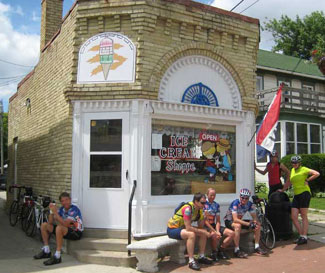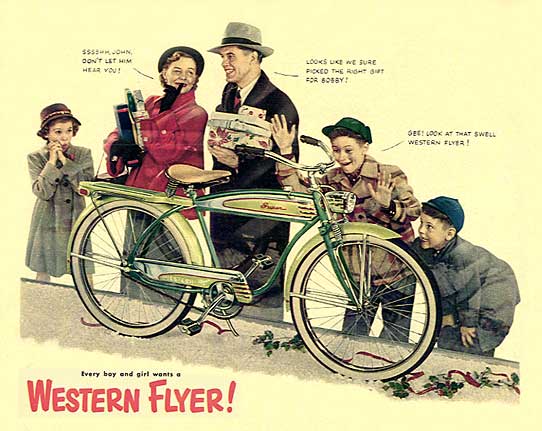Road racers. Loaded tourers. Recumbents.
Hardtails. Dualies. Hybrids. Cyclocross
bikes. Sport tourers. Commuters. Cruisers. Comfort bikes. Tandems. These
are just the more common bicycle types available today. There are also
folders, singlespeeds, freeriders,
downhillers, jumping bikes, track machines, travel
bikes and more. With such a dizzying array to choose from, it’s
a small miracle any new buyer wondering how to buy a bicycle leaves
a shop with the right model. Sadly, it’s common for people to buy
the wrong bike, such as getting a model built for abusive off-road use,
when the MTB will be ridden primarily on pavement.
To prevent such mistakes, if you’re in the market for a new bike,
especially if it’s the first new machine in a while, start the
shopping process by answering the key questions that follow. When you’re
sure about these things, you’ll stand the best chance of leaving
the shop with a bicycle you’ll love and not outgrow too quickly.
After you’ve nailed these questions, check my chart which explains
the five basic bike types to help decide which is most suited to you
and your riding plans.
 |
Why do you want a new bike?
Plenty of people buy the wrong bike because they only know they
want one. For example, maybe your friend bought a bike so you
want one just like it. That’s okay — if you plan to
ride just like your friend. It’d be better to list what you
want out of the purchase. Is it riding for fitness? Is it for
pedaling around town? For off-road excursions? For travel? To
take up bike racing? To commute? Write down as many reasons as
you can come up with and think carefully about which ones are
realistic.
|
 |
What kind of person are you?
Some types want the best of everything; others are frugal and
consider affordability first. A serious athlete will have different
goals than someone mostly interested in recreation. Tech heads
prefer the latest and most advanced engineering in frames and
components. Many cyclists want a unique machine that sets them
apart from the masses. One way to determine where you fit is by
thinking about other big purchases you made recently and the decisions
you made in the process. The better you know yourself, the easier
it’ll be to get a bike you’re happy with.
|
 |
What kind of riding do you want
to do?
Before answering, consider what type of riding is available in
your area. For example, it might be questionable to purchase a
downhill racing mountain bike if you live in Flatsville, Wisconsin
(where I took this photo). And, if you’re in Vertical, Vermont
and plan to pedal over hill and dale you probably don’t want
a one-speed model. So think about where you’ll bike.
If you’re not sure because you’re new to cycling
or the area, visit a local bicycle shop and ask the riders there
where the great cycling is to help decide which model will be
the most fun for you. And keep in mind, that if you like variety,
the answer may be two bikes, one for road use and the other
for off road use.
|
 |
How much do you want to spend?
Hit the shops with a good idea of what you’d be comfortable
spending. Every bike type is available in a wide range of prices
based on the frame material, the design and the components it’s
equipped with. If you can determine your price comfort level,
the dealer can steer you toward bikes of the type you like in
that general range and it’ll save searching the aisles. It’s
worth looking at slightly more expensive models to get a feel
for what a little extra cash buys. Often, for 15% more money,
you can get parts that would cost much more to purchase individually.
If you’ve got the bucks it might make sense to get the better
bike. But keep in mind also that there are essential accessories
such as a helmet and flat-tire repair kit that you may need and
that these will add to the total cost of the bike.
|
Bicycle Types
| Type |
Description |
Pros |
Cons |
Ideal Use |
| Road
racer |
Traditional
lightweight bike with skinny tires, dropped handlebars. Made to
be as efficient as possible for speed, quick handling and high-performance
climbing, descending and sprinting. A scream to ride fast. |
Most
efficient all-around performance. Excellent for racing and training.
Ultralight for easy climbing. Stiff frame excellent for sprinting,
climbing and jamming. Quick handling. Gorgeous to behold —
a study in minimalism. |
Ride
can be harsh. Flat tires are common (though it depends a lot on
equipment, how and where you ride and how much you weigh). Position
is often low and best suited to a very flexible person. If you're
scared of speed, the ride may be more excitement than you like.
May not accept fenders. |
Training
and racing on the road or century riding. Also can be used for
credit-card touring (carrying minimal gear and staying in hotels). |
| Road
sport |
Almost
identical to the road racer in appearance, this bike usually sports
a slightly more comfortable and slower-handling frame. The gearing
is usually a little lower to help in the hills. It’s possible
to easily install a rack and accessories such as fenders; not
always the case on a true racing bike. |
Longer
wheelbase absorbs road shock for more comfort than the racing
bike. Low gears mean less effort on the hills. Easier to carry
bags and accessories. Often comes with more padded seat and less
extreme rider position, which also increases comfort. More stable
on descents. |
Slightly
heavier. Climbs and handles more slowly than the road racer. |
Fitness
rides, centuries, commuting, distance touring. |
Mountain
bike
(within this category, there are full-suspension, dirt jumper,
all-mountain/freeride, downhill and hardtails (bikes with suspension
forks). |
Designed
like a Jeep for excellent performance on rugged terrain. Equipped
with a reliable sturdy frame, tough wheels with knobby tires,
upright handlebars, powerful brakes and a dependable drivetrain
with super low gearing. Available with and without suspension
though the former is most popular today. |
Escape
traffic! Bulletproof design means excellent durability (provided
you don't abuse the bike). Greatly reduced chance of flat tires
and bent rims. Incredible braking power. Very comfortable due
to wide tires and upright seating position. Total blast to ride
off-road. |
Can
be ridden on the road but isn’t efficient for long distances
without changing equipment. Hot property for thieves. You may
be tempted to take dangerous chances and crash a lot more than
you would on any other bike type. |
Trail
riding for fun, fitness and racing. And around-town use if you’re
not going far and aren’t in a hurry (just bring a lock!). |
Hybrid
(within this category, there are town/urban/commuter/city bikes
and comfort bikes). |
A bike
designed primarily for road use but capable of fireroad riding
as well. A sturdy frame of mountain-bike pedigree equipped with
wheels and tires made for road use and upright (sometimes backswept)
handlebars. Sometimes equipped with suspension seatpost and stem
to absorb road shock. |
Comfortable
rider position especially when equipped with shocks to absorb
bumps. More resistant to flats than road racers or road sport
bikes. Lighter than a mountain bike. Easy to carry stuff and mount
accessories. |
Not
great on the road or off the road. Not as fast or efficient as
a road racer or road sport, so not ideal for distance riding,
though better suited for it than an MTB. |
Fitness
riding on and off road, running errands and commuting. Okay for
touring though upright position not the most efficient. |
| Recumbent |
A long
and low road bike designed around an ergonomic seating position
where the rider sits in lawn-chair–like comfort and pushes
pedals located ahead of his body. Available with and without suspension. |
No
butt, neck, back, hand, shoulder or arm pain! The most comfortable
rider position of all bikes. Some are much faster downhill and
on the flats than other road bikes. Due to a long wheelbase, can
have very wide gear range meaning excellent lows for climbing
hills. Gets noticed everywhere you go. |
Takes
time to develop the muscles to ride a recumbent with complete
comfort (only if you’re used to upright bikes). Most are
slower on climbs. You get noticed everywhere you go. |
Fitness
riding, centuries, touring, training and racing in recumbent races. |
|

 Bike shopping was fun
— even in 1951
Bike shopping was fun
— even in 1951

